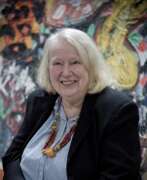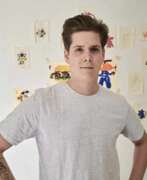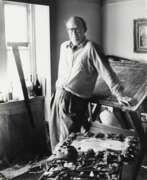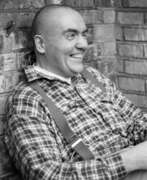United Kingdom Contemporary art


Richard Adams is a British artist and illustrator living and working in Sussex.
Adams received an honors degree in graphic design from Leicester Polytechnic and initially worked as an illustrator in London. Richard Adams creates all his paintings using chalk pastels, then fixes and impregnates with a special varnish that leaves an impenetrable surface. He depicts a variety of English landscapes and seashores, often inhabited by quirky characters and animals, as well as amusing domestic scenes. The artist successfully captures the humor and absurdity of everyday life in a bygone and contemporary English style.
Adams' work is regularly exhibited in London and other UK cities to great acclaim, and internationally in Sydney, Washington DC, Bremen and Madrid.


Darren James Almond is an English artist, based in London. He was nominated for the 2005 Turner Prize. He works in a variety of media including photography and film, which he uses to explore the effects of time on the individual.[3] He uses "sculpture, film and photography to produce work that harnesses the symbolic and emotional potential of objects, places and situations, producing works which have universal as well as personal resonances"


Banksy is a pseudonymous England-based street artist, political activist and film director whose real name and identity remain unconfirmed and the subject of speculation. Active since the 1990s, his satirical street art and subversive epigrams combine dark humour with graffiti executed in a distinctive stenciling technique. His works of political and social commentary have appeared on streets, walls and bridges throughout the world. Banksy's work grew out of the Bristol underground scene, which involved collaborations between artists and musicians. Banksy says that he was inspired by 3D, a graffiti artist and founding member of the musical group Massive Attack.


Phyllida Barlow is a British artist. She studied at Chelsea College of Art (1960-63) and the Slade School of Art (1963-66). She joined the staff of the Slade in the late 1960s and taught there for more than forty years. She retired in 2009 and is thus an emerita professor of fine art. She has had an important influence on younger generations of artists; at the Slade her students included Rachel Whiteread and Angela de la Cruz. In 2017 she represented Great Britain at the Venice Biennale.


Lucie Bennett is a British artist and graphic artist known for her provocative depictions of female silhouettes.
Many of Lucie Bennett's works are inspired by the similarities she has discovered between plant forms and the ornate structures of the human body's internal organs. The artist uses simple, elegantly applied lines and blocks of color to create distinctive works of art.


Walead Beshty is an American conceptual artist, photographer, sculptor and writer who lives and works in Los Angeles.
Born in London, Great Britain, he studied at Bard College and received a Master of Fine Arts degree from Yale University in 2002, and holds academic positions at universities across the United States.
Beschty is best known for his work in photography, but his creative interest spans a wide range, including sculpture, painting, installation and video. For example, in one of his popular works, the artist mails a series of glass windows of various sizes in cardboard boxes, and then displays the cracked and broken windows, damaged in transit, over the boxes in which they were packed.


Peter Thomas Blake is an English pop artist. He co-created the sleeve design for the Beatles' album Sgt. Pepper's Lonely Hearts Club Band. His other works include the covers for two of The Who's albums, the cover of the Band Aid single "Do They Know It's Christmas?", and the Live Aid concert poster. Blake also designed the 2012 Brit Award statuette.
Blake is a prominent figure in the pop art movement. Central to his paintings are his interest in images from popular culture which have infused his collages. In 2002 he was knighted at Buckingham Palace for his services to art.


Quentin Saxby Blake is an English cartoonist, caricaturist, illustrator and children's writer. He has illustrated over 300 books, including 18 written by Roald Dahl, which are among his most popular works.[a] For his lasting contribution as a children's illustrator he won the biennial international Hans Christian Andersen Award in 2002, the highest recognition available to creators of children's books. From 1999 to 2001, he was the inaugural British Children's Laureate. He is a patron of the Association of Illustrators.


Arun Bose was a prominent Indian artist born in Dhaka, then part of British India (now Bangladesh). He received his art education in Calcutta at the Government College of Arts and Crafts, graduating in 1955. Thereafter, he actively created and taught in Calcutta for the next seven years. In 1962, he travelled to the West where he learnt etching and studied mural techniques at the École Nationale Supérieure des Beaux-Arts in Paris. His many prints were made in aquatint and etching techniques with simultaneous colour printing. He later moved to New York, where he studied at the Pratt Graphic Centre and in 1968 received a scholarship from the Third John D. Rockefeller. He was also part of Robert Blackburn's workshop and taught printmaking himself at Queens College.
Arun Bose's paintings and prints are characterised by bright colours and abstraction, making his work unique and important in the art world.


John Bourne is a British artist and painter, living and working in Wales, and a member of the Stuckists art movement. He founded the Wrexham Stuckists group in 2001 and has been exhibited in the group's shows since then, including The Stuckists Punk Victorian. He has also taken part in Stuckist demonstrations against the Turner Prize. The subject matter for his paintings, which are done in a simplified style, comes from his memories.


Mark Boyle is a Scottish media artist from the British underground.
Since 1985 he and his wife Joan Hills and their children Sebastian and Georgia formed a collaborative art group called The Boyle Family. The Boyle family experimented with different techniques and styles. This included performances and events, films and projections, sound recordings, photography, electronic micro-photography, drawing, assemblage, painting, sculpture and installation.
However, their most famous long-term project remains Journey to the Earth's Surface, which they began in 1964 and which is a continuum of strange and interesting works. These paintings-very precise drawn casts, something in between painting and sculpture-are careful recreations of randomly selected sections of the earth's surface using resin and fiberglass, as well as real materials collected from the site under investigation.


Nick Brandt is a British photographer. He is known for his black and white photographs of wildlife and landscapes in Africa.
Brandt began his career in photography working as a music video director in the 1990s before transitioning to fine art photography. His work often depicts the animals of Africa in a powerful and emotive way, highlighting the beauty and fragility of these creatures and their natural habitats.
Brandt's photographs have been widely exhibited and are included in the collections of many major museums, including the National Portrait Gallery in London, the Museum of Fine Arts in Houston, and the Smithsonian National Museum of African Art in Washington, D.C. He has also published several books of his photography, including "On This Earth," "A Shadow Falls," and "Across The Ravaged Land."
In addition to his photography, Brandt is also the founder of the Big Life Foundation, a non-profit organization dedicated to the conservation of wildlife and ecosystems in East Africa. He has received numerous awards and honors for his photography and conservation work, including the prestigious Wildlife Photographer of the Year award.


John Randall Bratby was an English painter who founded the kitchen sink realism style of art that was influential in the late 1950s. He made portraits of his family and celebrities. His works were seen in television and film. Bratby was also a writer.


Lisa Brice is a South African painter and visual artist from Cape Town. She lives in London and cites some of her influences as her experiences growing up in South Africa during a time of political upheaval, and from time spent living and working in Trinidad.
Her work is held in collections around the world, including the Smithsonian National Museum of African Art, Johannesburg Art Gallery, The Whitworth, the High Commission of South Africa, London and the private collection of Sindika Dokolo.


Raymond Redvers Briggs was a British writer, illustrator, and cartoonist.
A professional illustrator, he worked on the design of children's books. In the 1960s, Briggs discovered his talent and ability to combine words and pictures, using a form of strip cartooning that defined his later work.
Briggs is best known for his wordless book The Snowman, published in 1978, a sort of cute children's tale but with deep meaning. The animated and musical versions of this book are popular in Britain and are shown annually at Christmas.


Benjamin Britten, full name Edward Benjamin Britten, Baron Britten, was a British composer, conductor and pianist.
Britten studied at the Royal College of Music in London, and had already written a set of choral variations, A Boy is Born (1933). He then worked as a composer for radio, theater and film, working closely with the poet W.H. Auden. His Variations on a Theme of Frank Bridge for string orchestra received international acclaim in 1937. Between 1939 and 1942 Britten worked in the United States, where he composed several significant works.
His later operas include The Rape of Lucretia (1946), the comic Albert Herring (1947), Billy Budd (1951), Gloriana (1953, written for the coronation of Queen Elizabeth II), and A Midsummer Night's Dream (1960). These and other works established his reputation as a leading British composer of the mid-20th century, whose operas are considered the best English works in the genre.
His song cycles occupy a significant place in Britten's oeuvre, and his largest choral work is War Requiem (1962) for chorus and orchestra. The composer wrote the Symphony in D major for cello and orchestra (1963) especially for the famous Russian cellist Mstislav Rostropovich. Britten's best-known works also include the opera Peter Grimes (1945) and the orchestral production The Young Person's Guide to the Orchestra (1945).
In addition to his work as a composer, Britten performed as a pianist and conductor, touring internationally and visiting the USSR on several occasions.


Jason Brooks is a contemporary British artist known for his fashion illustrations and portraits. He was born in 1969 and studied at Chelsea School of Art and Central Saint Martins in London. His work has been published in publications such as Vogue, Elle and The New Yorker.
Jason Brooks has worked with fashion brands including Chanel, L'Oreal and Christian Dior. As well as commercial work, he has exhibited his work in galleries around the world, including the Saatchi Gallery in London and the Museum of Modern Art in Tokyo.


Lionel Victor Bulmer was an English impressionist painter, a member of the New English Art Club, founded in 1886 as an exhibition society dedicated to promoting the avant-garde technique of French impressionist painting, the influence of which was clearly evident in Bulmer's own work.


Gary Bunt is a British self-taught artist known for his paintings of the English suburbs and countryside. He took up art to overcome a serious illness. Gary Bunt in a primitive style, with sophisticated simplicity and good humor depicts ordinary life with its simple joys.


Steven Campbell was a painter from Scotland.
Campbell's style of painting is figurative, with a hard linear quality to the application of paint. The colour palette is strong, with rich colours tending to be dominated by a blue-green light. Campbell would boast of being a very fast painter, although it has been suggested he liked to exaggerate claims like this.


Sir Anthony Alfred Caro was an English abstract sculptor who played a key role in the development of twentieth-century sculpture.
Caro trained at the Royal Academy School in London. In the early 1960s, he began making brightly colored abstract steel structures that he placed directly on the floor - the lack of a pedestal meant a radical shift in the dynamic between the work and the viewer. In addition to steel, he also created works in bronze, lead, silver, ceramics and wood, as well as on paper.


Terence Carr is a German painter and sculptor originally from Kenya.
Terence Carr, whose family emigrated to Africa from Ireland, was born in Nairobi, Kenya, where he spent the first 19 years of his life. In 1971, he traveled to England, where he became an officer in the British Army and then served in Germany. After gaining life experience, Carr enrolled at Augsburg University to study art education.
There is always an African influence in Carr's wooden sculptures, his peculiar language of forms. The artist hardly makes any sketches and immediately works directly on the wood with a chainsaw. Terence Carr uses constantly recurring symbols that reflect opposites - good and evil, love and hate, war and peace, pain, fear, suffering, tolerance and humanity. Animals with human features and people who look animal-like. Overall, it touches on the root issues of being human.
Over time, Terence Carr has become one of the most famous artists in the world. His works can be seen at exhibitions in different parts of the world and are represented in many significant collections.


Leonora Carrington was a British-born Mexican artist, surrealist painter, and novelist. She lived most of her adult life in Mexico City and was one of the last surviving participants in the surrealist movement of the 1930s. Carrington was also a founding member of the women's liberation movement in Mexico during the 1970s.


Jake Chapman, born Iakovos Chapman, is an English conceptual artist who works almost exclusively with his older brother Dinos Chapman. Together they are known as Jake & Dinos Chapman and became famous as members of the Young British Artists, brainchild of media mogul and collector Charles Saatchi. The brothers usually create works using plastic models or fibreglass mannequins, which often cause scandal.


Dinos Chapman (born Konstantinos Chapman) is an English conceptual artist who almost always works with his younger brother Jake Chapman. Together they are known as Jake & Dinos Chapman and became famous as members of The Young British Artists, brainchild of media mogul and collector Charles Saatchi. The brothers usually create works using plastic models or fibreglass mannequins, which often cause scandal.


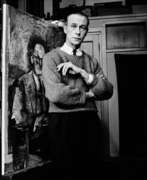

Sir William Menzies Coldstream (CBE) was an English realist painter and teacher. His type of realism was based on careful measurement by the following method: standing in front of the subject being depicted and holding the brush vertically at arm's length. Coldstream painted still lifes, landscapes, portraits, and nudes of women.


Nigel Cooke is a British painter who currently lives and works in Kent. His paintings depict carnivalesque figures set within harsh landscapes that are littered with urban decay. The paintings imply a strong sense of foreboding both through the depicted forms such as skulls and derelict buildings and also through his use of colour which often features bilious toxic greens. The paintings develop and change over a protracted period of time and are built up though many layers of oil paint. The paintings often balance different languages of paint within the same canvas. Vast areas of colour are combined with obsessively detailed figuration and in recent works Cooke has incorporated large sweeping gestural marks into his compositions.


Hans Coper was an influential German-born British studio potter. His work is often coupled with that of Lucie Rie due to their close association, even though their best known work differs dramatically, with Rie's being less sculptural, while Coper's was much more abstract, but also always functional.


Ken Currie is a Scottish artist and a graduate of Glasgow School of Art (1978-1983). Ken grew up in industrial Glasgow. This has had a significant influence on his early works. In the 1980s Currie produced a series of works that romanticised Red Clydeside depicting heroic Dockworkers, Shop-stewards and urban areas along the River Clyde.


Matthew Darbyshire is a British artist. He is known for his multimedia works that explore contemporary consumer culture and the built environment.
Darbyshire often works in sculpture, installation, and photography, using materials such as concrete, metal, and plastic. His work often references the aesthetics of modernist architecture and design, and he frequently incorporates found objects and images from popular culture into his pieces.
In 2014 Darbyshire created the polystyrene sculpture Hercules, which is an imitation of the Farnese Hercules. The deliberate choice of a white material has been interpreted as a perpetuation of colourism in how we view and understand classical sculpture.
Darbyshire's work has been exhibited in major museums and galleries around the world, including the Tate Britain in London, the Museum of Modern Art in New York, and the Venice Biennale. In 2015, he was shortlisted for the Hepworth Prize for Sculpture.
His work is noted for its critical engagement with consumer culture and the built environment, as well as its use of humor and playfulness to explore complex social and cultural issues.


Ian Davenport is an English abstraction artist known for his intricate compositions of streams of colored paint flowing over surfaces. All of Davenport's work involves experimentation: he uses various industrial and domestic tools, including wind machines, hypodermic syringes, and watering cans, to manipulate the paint and to draw as much attention to the process of creating artwork as to the finished works themselves.


Edmund Arthur Lowndes de Waal is a contemporary English artist, master potter and author. He is known for his large-scale installations of porcelain vessels often created in response to collections and archives or the history of a particular place. De Waal's book The Hare with Amber Eyes was awarded the Costa Book Award for Biography, Royal Society of Literature Ondaatje Prize in 2011 and Windham–Campbell Literature Prize for Non-Fiction in 2015. De Waal's second book The White Road, tracing his journey to discover the history of porcelain was released in 2015.


Richard Deacon is a Welsh sculptor. He is known for his abstract sculptures that explore the relationships between form, space, and materials.
Deacon initially studied at the Somerset College of Art in Taunton before going on to study at the Central Saint Martins College of Art and Design and the Royal College of Art in London. He began his career as a sculptor in the 1970s and has since become one of the most prominent British sculptors of his generation.
Deacon's sculptures are often made from materials such as laminated wood, steel, and ceramics, and take on a wide range of forms, from organic and biomorphic to geometric and architectural. He is known for his use of curves, lines, and bold colors, as well as his exploration of negative space and the relationship between objects and the space around them.
Deacon has exhibited widely throughout the world, including at the Tate Gallery in London, the Museum of Contemporary Art in Los Angeles, and the Guggenheim Museum in New York. He has been awarded numerous honors for his work, including the Turner Prize in 1987 and a CBE in 1999.


Edward Maurice FitzGerald "Robyn" Denny was one of a group of young artists who transformed British art in the late 1950s, leading it into the international mainstream. Reacting against the mainstream St Ives School of landscape-based painting and inspired by Abstract Expressionism, American films, popular culture and urban modernity, they saw abstract painting as their only conceivable route.


Peter Doig, a Scottish painter, is renowned for his distinct, evocative style that captures elements of the natural world intertwined with a sense of the fantastical. Known for his vibrant use of color and imaginative landscapes, Doig's works often explore themes of memory and nostalgia, heavily influenced by his experiences in Canada, Trinidad, and the United Kingdom.
Peter Doig’s journey in the art world gained significant momentum after his education at Chelsea College of Arts, which was followed by his winning the prestigious Whitechapel Artist Prize in 1991. This recognition led to a solo exhibition at the Whitechapel Art Gallery where he showcased key works that helped define his career, such as "Swamped" and "The Architect's Home in the Ravine."
Throughout his career, Peter Doig has demonstrated a mastery of painting, evident in works like "White Canoe" and "Echo Lake," which reside in major collections such as the Tate and the Saatchi Collection. His art not only reflects his personal history and travels but also incorporates elements from cinema and photography, giving his paintings a dream-like quality that invites viewers to interpret their narratives.
Peter Doig's work has been exhibited worldwide, including significant retrospectives at the Fondation Beyeler in Basel and the Louisiana Museum of Modern Art in Denmark. His achievements in the art world have been recognized with numerous awards, including being named the 2017 Whitechapel Gallery Art Icon.
For those interested in the contemporary art scene, Peter Doig remains a pivotal figure whose works continue to inspire and provoke deep reflection. Art collectors and enthusiasts keen on following updates related to new sales and auction events featuring Doig’s work can sign up for targeted updates here.




































